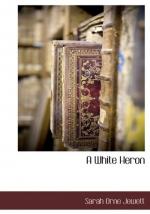|
This section contains 2,678 words (approx. 9 pages at 300 words per page) |

|
SOURCE: “America's ‘Lonely Country Child’: The Theme of Separation in Sarah Orne Jewett's ‘A White Heron,’” Colby Library Quarterly, Vol. 14, No. 3, September, 1978, pp. 166–171.
In the following essay, Hovet analyzes “A White Heron” from a Freudian perspective, determining that the work portrays both the conflict between urban society and the natural world and also the separation of the adult world from that of the child.
When she was forty-eight years old, Sarah Orne Jewett thought back to 1857 and wrote, “This is my birthday and I am always nine years old.” As F. O. Matthiessen shows, the “whole fading world” of pre-Civil War America as it was manifested in Maine continued to hold “the center of her affections.”1 But Jewett's love of her childhood and the past grew into much more than an astute observation of regional characteristics and the delicate rendering of a vanishing people and culture. As “A...
|
This section contains 2,678 words (approx. 9 pages at 300 words per page) |

|


